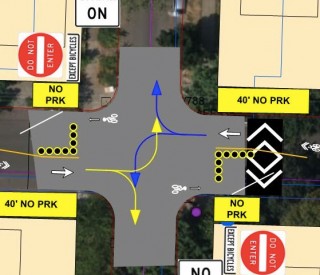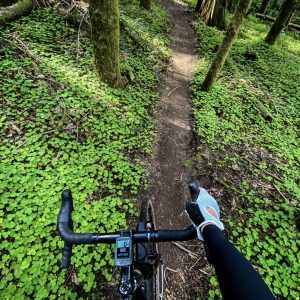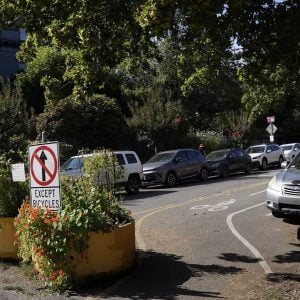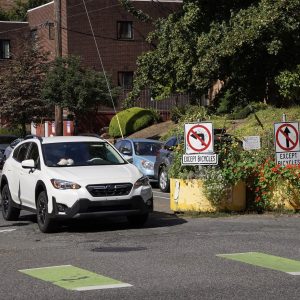The Portland Bureau of Transportation is moving forward on their plans to tame auto traffic on Southeast Clinton.
In a statement released today, the city clarified their intentions to install diverters and take other actions to improve cycling conditions and discourage people from driving on Clinton — a street set-aside as a low-stresss bicycling route that has seen traffic skyrocket as nearby Division Street has added housing and businesses.
As part of their Clinton Neighborhood Greenway Enhancement Project, here’s what PBOT has announced:
- Diverters at SE 17th and 32nd. These median islands will be installed on a trial basis and will prevent people from driving east-west, while allowing those on bicycles to continue through.
- SE 34th Avenue will be converted into a one-way northbound street for people biking and driving, with bicycle users being given a new “contra-flow” lane in the southbound direction.
- Clinton between SE 12th and Cesar Chavez Blvd (39th) will be signed for 20 mph speed limit if traffic is reduced to below 2,000 cars per day (it currently carries around 2,300 cars per day).
- Speed bumps will be installed east of Cesar Chavez Blvd.
- A public awareness campaign will start in the next few weeks. This effort will include signs to educate people about why diversion is necessary and raise awareness about how to drive courteously on Clinton.
- A citizen’s advisory commitee will be convened next spring to “assist in the evaluation of the trial period and recommend if modifications are needed for the project’s second phase.”
PBOT plans install the diverters by the first week of January (2016), using the next month or so for their public outreach plan. The diverters will remain for a six-month trial period. The speed bumps east of Cesar Chavez will be installed next spring in warmer weather.
Advertisement
The changes to 34th aren’t directly related to the problems on Clinton, but PBOT is jumping on this opportunity to improve the street. With a signal at nearby Division, 34th is a major north-south connector. It’s also very narrow and people who live there have urged PBOT for over a year now to remove a parking lane and add a bike lane.
This announcement will be welcome news for many people who bike on Clinton. The diverters were intially promised by fall but PBOT waited to move forward while they garnered support, public feedback, and political buy-in. PBOT got a big policy and political boost when City Council unanimously passed a report about neighborhood greenways back in August.
One key new policy adopted in that report: It puts the acceptable threshold for a “safe and functioning neighborhood greenway” at 1,500 cars per day or fewer, thus giving PBOT the leverage to make design changes until that traffic level is reached.
As for the public, there’s been little to no opposition to do something about the traffic on Clinton. The only disagreements have been about where to put diverters, how many to install, and whether or not the changes might lead to spillover traffic on other streets (PBOT says it won’t).
During a phone interview today, PBOT project manager Rich Newlands said the public awareness campaign will be key to this project. “This conversation has been focused around the neighborhood, but our audience in terms of what we’re trying to achive is very much outside the neighborhood.” Newlands was referring to traffic analysis that showed during rush hour over half of the auto traffic comes from outside the ZIP code.
PBOT spokesman Dylan Rivera said they’re also in talks with the Portland Police Bureau about special enforcement actions in the area once the medians are installed.
The issue of too many people using Clinton as a cut-through was first flagged as a concern by advocates and even PBOT’s own staff nearly five and-a-half years ago. After City Council passed the Division Streetscape Project in 2010, PBOT bicycle coordinator Roger Geller said, “We already want to do something on Clinton because the auto volumes are too high.” Also at that time the Bicycle Transportation Alliance foresaw the problem and got the city to insert a promise into that plan that they would address cut-through traffic on Clinton if and when it became a problem.
Geller and the BTA were right. And when the issue reached a boiling point in the past year, a new group of activists, BikeLoudPDX, grabbed the football and ran it into the endzone.
For more on this story, browse our archives. You can learn more about the project and see design drawings of the diverters and changes coming to 34th at PortlandOregon.gov.
— Jonathan Maus, (503) 706-8804 – jonathan@bikeportland.org









Thanks for reading.
BikePortland has served this community with independent community journalism since 2005. We rely on subscriptions from readers like you to survive. Your financial support is vital in keeping this valuable resource alive and well.
Please subscribe today to strengthen and expand our work.
January. Will this be the last postponement? I sure hope so.
They didn’t say *which* January.
I think another survey is in order.
(Are we strong enough to handle teasing here?)
Glad that the diverter at 32nd is still planned despite the opposition. Looking forward to finally seeing this project on the ground!
On the bright side – even with the delays, this project will be faster than the CRC, WAY less expensive, actually helpful rather than a gigantic subsidy to sprawl, and it looks like it’s going to actually happen! 🙂
Alex, I loved the “endzone” comment and link. Thanks for pulling us together.
Thanks Marsha! (And Jonathan – clicking that link was a fun trip down memory lane… 🙂
I could be wrong, but I don’t think January is in the summer.
Hard to know, give it a few dozen more ppm of CO2 and all bets are off.
Channel your inner Aussie and summer in January is about right.
Let us all be reasonable and continue supporting the process.
Heck, they could use this design at 21st & Clinton to keep traffic from turning off 21st onto Clinton westbound, which the Lancaster data shows is a huge problem currently.
Start asking for it for Phase II.
I’ll believe in Phase II when I see Phase II.
All conversations about diverting between SE 21st and SE 26th are met with “TriMet can’t move the #10 bus!!!” I asked at the open house in September why the 4 was able to make the turn from Division to 26th when Division was closed east of SE 26th for paving. The answer was, “That is a turn you can make if you have to, not one you want to do regularly.” I think this is the sole reason nothing is happening in that stretch during Phase 1.
As far as Phase 2 goes, I’m not giving up unless I stop breathing. It’s a Safe Route to School for 6+ schools and it needs to be safe enough for Kindergarteners and their grandparents to ride it.
untrue. PBOT has already analyzed how the #10 can move with minimal redesign to the intersection at Division and 26th. It just has to turn the corner from the through lane. A convenient stop location is one sticking point, near 25th, or after turning onto 26th?
*I* think it’s untrue since the #4 did it. I don’t think there’s a need to have a stop different than the one the #4 uses at 26th/Division. What I was saying is the response I got to asking why the #10 can’t if the #4 could.
Turning the corner eastbound to southbound requires a much larger corner radius than currently exists. So large that the sidewalk there would disappear, so you would have to buy property at the corner to put back a sidewalk. Turning from the through lane also requires a larger radius, but not so large that acquisition of right of way is needed.
Help us convince trimet to reroute the #10.
https://trimet.org/schedules/r010.htm
(If PBOT made a change unilaterally they would almost certainly be sued.)
That would certainly make things easier, though it’s not strictly necessary. I know it’s been tried before, and I know it didn’t work. Maybe this time will be different?
Hey, how about a constriction to one lane at, say Clinton & 24th, with a “Bus Only” sign?
23rd, taking out the roundabout to put in something more like at 52nd & Division? I’d get behind that.
Take out all the despised-by-all small traffic circles. Probably not the most effective way to spend limited dollars, though.
I don’t despise the traffic circles… what’s wrong with them?
They encourage conflict by allowing enough space for drivers to attempt to squeeze past people cycling.
Only if a rider leaves enough space to tempt the driver to pass them. With safe riding habits, this is a non-issue. (Though I concede that not everyone rides safely in this respect; some riders also habitually ride in the door zone, and don’t use bike boxes properly.)
I really like the circles because they help send a message that the street is not an ordinary one, and they add more vegetation to break up the landscape.
(This is actually a reply to Hello, Kitty. The “Reply” link wasn’t there, presumably because of how nested things are.)
I agree with Soren. I take the lane, am passed on hills by cyclists on the right and left, along with car drivers on the left. At the SE 23rd/Clinton circle I was taking the lane and was still passed by a driver on the left; you can see my report on almostkilled.me. I had to jump off the bakfiets and tip it hard to the right to keep the car from colliding with the box. Luckily I didn’t completely dump it as my son was riding with me at the time. To say that properly controlling the lane will prevent an aggressive driver from passing unsafely is naive.
That sucks.
I wonder if a strategically placed sharrow in the immediate approach to the circle would help signal drivers where to expect a cyclist.
I think that the average driver has no clue what sharrows mean. I wish we had more driver education required in regards to how to share the road with other modes and more frequent renewals (which would also require testing). Heck, except for biking activists, I get blank stares and lots of blinking when I say, “Share the road does not mean share the lane.” There is a serious lack of knowledge about laws and what specific ones are meant to do out there. At this point I’d be willing to bet that most of the people that park illegally close to intersections have no idea that it is illegal.
HK,
What about the businesses near 21st? The Lancaster counts found about 148 AM north to west turns, the same number continued north. Some of that traffic may be related to retail use at 20th and Division. Why not a semi-diverter at 20th at Clinton so southbound has to go east and westbound has to go north?
I don’t think the business in that cluster are AM traffic generators (mostly restaurants and such). When the weather was nicer, I spent a couple of hours on that corner watching the AM traffic, and, aside from one landscaping truck, there vehicles turning onto Clinton kept going.
A diverter at 20th might achieve a similar goal, though I do know (anecdotally) that there are some drivers who use 21st->Clinton->20th->Division as a way to get around the signal at 7 Corners. This strategy may become more popular after the diverter at 17th is installed. Personally, I’d rather have vehicles driving straight along Clinton than have lots of people turning on and off. I have no data, but that pattern seems more dangerous.
HK,
The trouble with diverters is that they are 24/7/365 and the problem is mostly the AM peak, per the Lancaster report.
I suspect you are right, but the Lancaster report did not contain enough data to say one way or the other (they only counted during peak hours, right?)
In any event, you could make the same argument about any diverter — the bulk of the problem is always in the peak hours, yet the installation is always “on”. What would make this one different?
The city data of license plates found half the people driving on Clinton are from outside the neighborhood (liberally defined). they can’t all be commuters. Some will be owners/workers and some will be patrons, likely looking for a place to park.
Balancing the needs of non-motorists with those choosing to drive who all support the local retail is part of the puzzle PBOT is tasked with solving.
In the morning they are probably mostly commuters (there just isn’t much going on at 21st & Clinton at 8 AM). However, why does your argument apply to one diverter and not another? Many drivers at 31st & Clinton are probably locals or owners/workers of the nearby businesses.
Rich touched in this in the last meeting (11/5). Some of it was during the presentations, but some might have been after when I was talking to him about my street.
There are commuters, some cutting through the neighborhood from outside and some residents of the neighborhood that are using Clinton instead an arterial. Changing the behavior of these residents is also part of the plan. Then there are destination drivers who are coming into the neighborhood to patronize a business (or visit a friend, I presume). These are not people they want to deter or behavior they want to change. I found it interesting that PBOT isn’t just saying “stay out if you’re from another zip code,” but that they are aware that some of the push-back is from the neighbors who are going to have to change their behavior and who are going to have to accept that destination drivers are a Good Thing.
Hang on, did I read that right? Speeds will only be lowered if the number of cars on the street are lowered? Seems a little backwards, that.
As usual it is state law that is the problem. We need to stop electing business-friendly blue dog democrats to the Governor’s office.
Yup, it’s a Catch 22. They require lower volume in order to lower the limit, but we can’t get the lower volume, in part, because the speed is the same as Division, one block over. Division has the same speed limit, more bus traffic, more red lights, more marked crosswalks, and more peds crossing the street. It really is no wonder why Clinton has the car traffic it does.
Hopefully the diverters will cause the volume will go down, and once the volume is down, we’ll get the lower speed limit. Not that they would ever do speed enforcement there though. They simply do NOT do speed enforcement in neighborhoods, where it is needed most. Ever.
My understanding from working with PBOT (and indirectly ODOT) on speed changes in our neighborhood was that this is not necessarily always the case. They can change the limit based on speeds and not volume if they want to.
Well, yes… but I’m going to guess that locations where 85% of traffic is already going 20mph or below are not the locations where neighbors & advocates are likely to be pressing PBOT to post 20mph speed limit signs.
There are several tracks to achieve a speed different than the usual statutory speeds:
1. the (2nd?) longest is to ask ODOT to designate a speed limit. this takes at least 6 months for a study and I’ve never heard of them posting a speed below statutory. The study relies heavily on 85th percentile and comparing the subject street’s safety record to comparable streets (grading on a curve). If the street is operating safer than average, good luck.
2. If traffic volumes on a road are below 2,000 vehicles per day, 85th percentiles are under 30 mph, and the road is designated (on an approved map) for shared use with cyclists, any jurisdiction can lower the statutory speed by 5 mph under current law – this is the path PBOT is pursuing.
3. Any ‘narrow residential roadway’ (18 ft or less of ‘travel space’) can be posted for 15 mph. So a road 32 ft wide with 8 ft parking lanes, in theory, has 16 feet of roadway remaining for ‘travel’. Portland has lots of these streets. Will to attempt to exploit the law as it is written, is another thing.
4. The admin code permits Portland to pursue an alternative method for setting speed limits, with caveats, and PBOT is pursuing this.
5. Changing the statutory speed for residential districts from 25 to 20 mph, ala Safe Systems, would require legislative action.
6. Devolving speed limit setting authority, and liability, to cities in Oregon with, say, more than 400,000 population ( I know of only one) would also require legislative action.
“4. The admin code permits Portland to pursue an alternative method for setting speed limits, with caveats, and PBOT is pursuing this.”
Very glad to hear this.
How about some enforcement around these intersections when the diverters are finally installed? I anticipate a lot of …interesting… driving from people who stumble upon the changes on their way home.
I anticipate a huge potential for left-cross collisions as motorists turn in front of bike through traffic.
Anyone know of the legality of neighbors directing traffic? I swear I’d let the car drivers turn. Eventually.
Ankeny, you’re next.
And Couch.
And NE Everett/Davis/Couch
NE Tillamook-Hancock
SE Ladd-Harrison/Lincoln
NW Johnson
NW Marshall
NE Alameda
SE Ankeny
Probably.
Ankeny has so many new apartment buildings going up, that car traffic is going to get heavier very soon.
On the positive side, Burnside flows pretty well and there is already the diverters at 20th and at 32nd. So I don’t think it will be as trafficked as Clinton. But I think some action there will be needed all the same.
I’ve seen drivers pretty regularly hop right over that diverter at 20th. It would be nice to upgrade it to something more robust, or at least add wands to it.
Other than that there should be diverter at Sandy or 12th, and maybe one at 28th.
Upgrade = spikes mounted on top of the curb?
That’s in the discussion for upgrades.
Ankeny between 12th and 18th has cut-through rush hour traffic and speeds are also high in the 20s. PBOT proposed a diverter somewhere around 15th and more speed bumps between 20th and 28th.
I personally would like to see another diverter/half diverter installed near 28th.
Semi diverter west of 28th is one proposal. It would only permit eastbound movement for autos.
Now if we can only convince PBOT that this upcoming period of dry weather would be the perfect time to lay the paint on 34th.
No parking zones next to intersections?
What a crazy idea…….
When the city brings up state law as a reason for not doing something be sure to point out how they have a policy of ignoring state law when it comes to parking near intersections.
You can find many instances in Portland where the parking near the intersection on narrow roadways has been removed. Several of the cross streets on Fremont east of 42nd had this done as part of the pedestrian safety project out there.
But not nearly enough. I’m continually amazed there aren’t more crashes in Portland with poor sight lines do to encroaching parked cars.
The 40-foot no parking zones might be to facilitate emergency vehicles. (“Semi-diverters may affect curbside parking opportunities opposite the device to permit emergency vehicle access.” – https://www.portlandoregon.gov/transportation/article/83903.)
As for the 20-foot no parking zones, those are automatic at most intersections in Oregon thanks to ORS 811.550 (17). People violate this law all the time in this neighborhood and it causes serious problems with visibility.
As noted on this page, the city is planning a public awareness campaign that will include “how to drive courteously on Clinton”. This campaign needs to be very clear about ORS 811.550 (17), and the city needs to enforce it.
The graphics display where parking will be lost that has been used in the past, not necessarily where signs will be installed.
It’s unfortunate to have a speed bump just inside the bike-only side of the diverter. (Perhaps it’s possible to remove it on that side?)
Exactly what will the physical design of the diverter be?.
The diagram says the diverter will allow cars to turn north or south, but not continue through east or west. I’m having trouble visualizing how this will be accomplished, in a way that physically prevents drivers from illegally maneuvering around the diverters to continue east or west.
I had originally expected a diagonal barrier across the whole intersection so that east bound cars could only turn south, and west bound cars could only turn north.
What I mean is: if the black dots with yellow outlines signify bollards, then drivers will simply detour around them. No harder than maneuvering around a double parked car.
The sign “do not enter except bicycles” should be enough. Granted, some drivers can’t follow rules and would prefer to have severe tire damage strips to keep themselves honest.
Our house, in the middle of the street Our house, … Our house, in the middle of the street Our house, that was where we used to sleep.Our house…
5 and 1/2 years it took.
Just think of that….5.5 years for two diverters and some striping.
It’s a good thing they didn’t take on something really monumental.
The city that works.